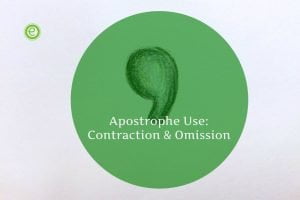Today we are going to learn about how to use apostrophe in contractions and in omissions, along with usage examples and rules.
English is a very interesting language that deals with a lot and lots of grammar. This is where most of the people freak out. By listening to the word grammar makes them. It is quite common because English grammar tends to be a little tricky. But it never means that you cannot learn English Grammar. Yes, it is true that you need to put in extra efforts to understand the rules as well as the exception of the English Grammar. With this positive attitude toward grammar, you won’t feel that it is hard and impossible to learn.
One such set of punctuation that can be a nightmare for you is Apostrophe. People make loads of error while using the apostrophe in their content. What is it used for? How it should be used properly?
Before moving ahead, we should know what exactly is an apostrophe.
What is An Apostrophe?
In English Grammar, it is a form of punctuation mark that ensures that the readers have clarity in knowing the function of nouns significantly by indicating possession and showing different cases of omission.
You must be aware that an apostrophe has 3 basic functions:
The First Function – The Use In Possessive Noun – You can add an apostrophe to the singular words as well as plural words. In the case of singular words, the apostrophe appears in between the word and the ‘s’. Whereas in the case of plural words the apostrophe will appear after the ‘s’.
For example,
- It is Maria’s doll.
- It must be the Mohan’s bike.
- The beautiful castle is of Queen’s daughter.
Making use of the Apostrophe in the plural form
- These are platypus’ eggs.
- Have you ever seen so many walrus’ tusks?
The second form in which you can make use of Apostrophe is – Contraction And Omission: The first and foremost thing that we need to understand here is the word contraction. Basically, contractions are words in which two different words can be combined to form a single word. This can be done by omission or combination of sound and letters. You can make use of contractions in written as well as spoken English as it can be acceptable in most of the formal writing.
For simplification, you can check the given below words
- can’t (cannot)
- don’t (do not)
- he’s (he is)
- I’m (I am)
- isn’t (is not)
- it’s (it is)*
- mustn’t (must not)
- she’d (she had/she would)
- that’d (that would)
- there’s (there is)
- they’ve (they have)
- ’twas (it was)
- we’re (we are)
- won’t (will not)
- you’re (you are)
Apostrophes and Plurals
When we need to use an apostrophe in case of plural terms of a noun then it is one of the common mistakes. It is also considered as the grocer’s apostrophe. This is because it is frequently spotted in the grocery store advertisements. It has few exceptions apart from the basic rules. If you are in the writing industry, then it is very important to understand the proper use of punctuation in the English language. You can have a quick glance at the street signs, various advertisements, and stores that would demonstrate the use of the mark in a proper way.
It is not surprising to know that the apostrophe has only two uses; one is to show possession of a thing or places (basically nouns) and other is to indicate the omission of letter or numbers.
How to work with Apostrophe By Writing Joint Possessions?
Just in case when you are referring to things that belong to more than one person then what would you do? How will you make use of Apostrophe when there are multiple owners of a single thing? Let’s see the example below to understand the working.
- Maria and Jenny’s Bait shop has been prospering.
- Joseph and Merline’s parents are not at home.
You can see that only the final name shows the use of possessive punctuation mark – Apostrophe.
List of Common rules that need to be checked before using Apostrophe
- If it is a singular noun or does not end with ‘s’ then you must add ‘s’ along with the punctuation mark.
- If you refer to the noun that is singular and end with ‘s’ then you need to add ‘’s’.
- In case you are referring to the plural nouns and if it is ending with ‘-s’ and just add the apostrophe.
- If the noun you are using is plural and does not end in ‘-s’ then you need to add ‘`s’.
Conclusion:
You have been learning about an apostrophe and the common rules that go with it. EnglishBix will be back with yet amazing punctuation marks and their usage. Stay Tuned!


